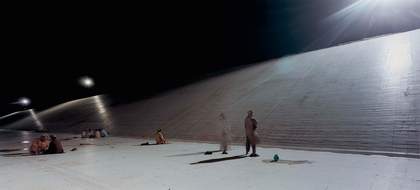
Armin Linke
Ghazi Barotha hydroelectric scheme, workers praying Hattian, Pakistan 1999
C-type print
150 x 200 cm
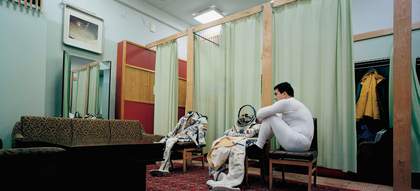
Armin Linke
Star City ZPK, Moscow, Russia 1998
C-type print
150 x 200 cm
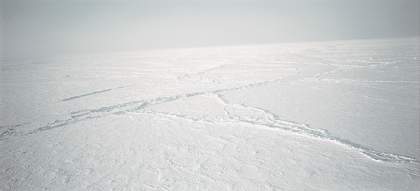
Armin Linke
Polar Cap, Artic North Pole 2001
C-type print
150 x 200 cm
© Tate
Armin Linke has a studio in a humdrum part of Milan, but if one wishes to do more than catch a glimpse of this peripatetic photographer, one needs to travel with him. He packs his bags whenever something grabs his attention. At first this has nothing to do with the camera, but everything to do with his eye and a disarming intelligence. Linke quietly scrutinises his chosen location, selecting a view that is of a scope and depth to warrant taking a picture. One day in Iraq, before the last war, he did just that, some distance from one of Saddam Hussein’s palaces on a slope of asphalt and sand. While he set up his camera, a group of men uniformly dressed in black walked into his view. They were leaving the palace after bearing birthday wishes for the president. The resulting photograph is really composed of two images: one is premeditated, taking in the sweep of a symbolic site (with few or no symbols, apart from the tall lamp posts, as if it were an airport); the other is created by coincidence. It is precisely the accidental that endows the picture with an uncanny meaning: men are leaving the site of power, as if the place were to fall vacant at their departure. By dint of its dual nature, the image enfolds a brief moment within a static frame. Linke caught an instant (gone the moment he snapped the picture) whose symbolic time had not yet come, but whose enduring backdrop ceased to hold any significance. Instead of fading into obsolete reportage as the years go by, the picture continues to acquire incalculable references.
Linke has a keen eye for places on the verge of historical change or in the throes of transformation. Gigantic construction sites, mining pits and hydroelectric dams figure among his growing inventory of images, to which we can add polar regions, Soviet cosmodromes and Chinese cities. In these pictures, the photographer’s gaze remains steady, even unblinking, taking no umbrage and making no excuses. The sheer vastness of some of the locations is matched by their emptiness, by the fleeting presence of workmen in the far distance, or by a thin plume of dust as the only sign of human transience. An overwhelming discrepancy of scale, often under unstable skies, causes doubt about what one sees. Can it be true? What if one actually were in such a place?
Because Linke retouches his pictures only in the rarest of circumstances, digitally dampening brightness or enhancing the howling desert of polar ice, they look compelling. He remains a staunch opportunist in his conviction that photographs achieve their character as a record of sites and occurrences rather than through the artifice of the photographer. He eschews shallow depths of field such as Gabriele Basilico has recently imposed on his urban landscapes, and he would never edit his photographs in the calculated way that Andreas Gursky manipulates and inflates his images to almost hypnotic effect. Linke remains a reporter at heart, attuned to occasions and prepared for their disruptive moment.
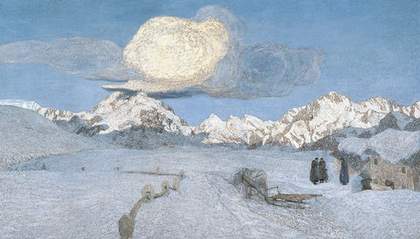
Giovanni Segantini
Death from the Alpen Triptych 1898–9
Oil on canvas
190 x 322 cm
Courtesy Segantini Musem, St Moritz
As we drive up the Brenner Pass, on our way to the inauguration of the new Museum of Modern and Contemporary Art in Bolzano, we ascend into a pocket of Italy that belongs to both northern and southern Europe, harbouring palm trees and lush gardens at the foot of snowcapped mountains, a hybrid world in which everything carries two names, one in Italian, the other in German. Linke, a German who grew up in Italy, should feel perfectly at home in this region. He left art school early and moved to New York, where he found himself on the scene of artists and literati whose pictures he snapped as if he were compiling an album of his workaday experiences. Casa Vogue discovered his cache and kept him busy with requests for more. The reporter in him was awakened and nurtured in the hothouse of galleries and fashion magazines.
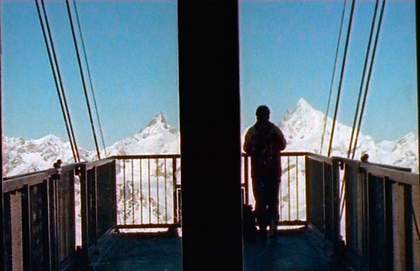
Film stills from Armin Linke's video installation Alpi Film Project (2008)
Courtesy the artist © Armin Linke
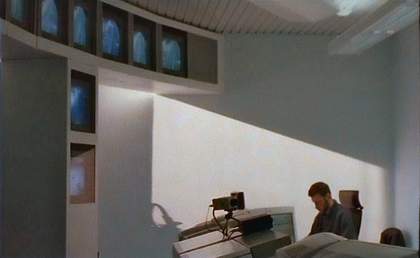
Film stills from Armin Linke's video installation Alpi Film Project (2008)
Courtesy the artist © Armin Linke
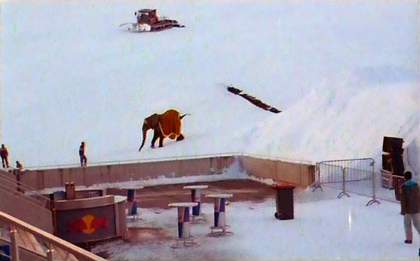
Film stills from Armin Linke's video installation Alpi Film Project (2008)
Courtesy the artist © Armin Linke

Film stills from Armin Linke's video installation Alpi Film Project (2008)
Courtesy the artist © Armin Linke
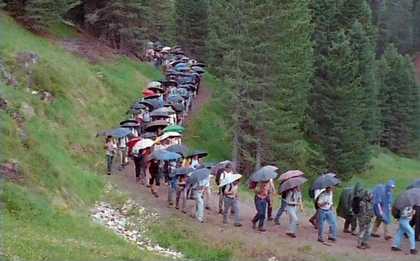
Film stills from Armin Linke's video installation Alpi Film Project (2008)
Courtesy the artist © Armin Linke
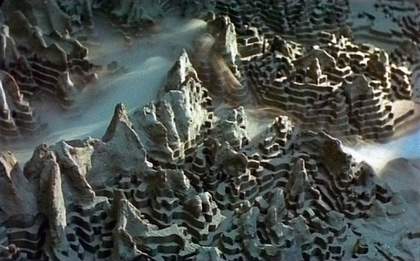
Film stills from Armin Linke's video installation Alpi Film Project 2008
Courtesy the artist © Armin Linke
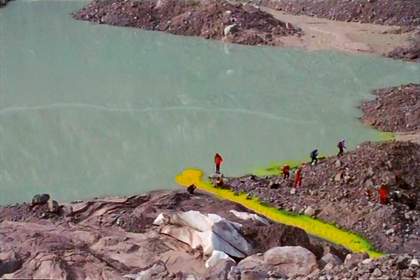
Film stills from Armin Linke's video installation Alpi Film Project 2008
Courtesy the artist © Armin Linke
Linke knows that for a photograph to warrant more than the lightning response we’re accustomed to according it, the image must hold something that we sense but cannot necessarily see. Only pictures that arrest the viewer’s attention can escape automatic dispatch. This resistance may be fragile, but it needs to be obstinate. On the one hand, the unfamiliar may prompt us to look more closely; on the other, what we already know may hold even more of a mystery when it is rendered anew. Linke has taken many memorable photographs in both of these categories: the ramshackle cabins in which Russian cosmonauts changed into their space gear suggest booths in a discount clothing store; Pakistani construction workers praying during their night shift under the glare of lights at the foot of a concrete dam could not have been watched with more respect, but also with an unyielding will to observe.
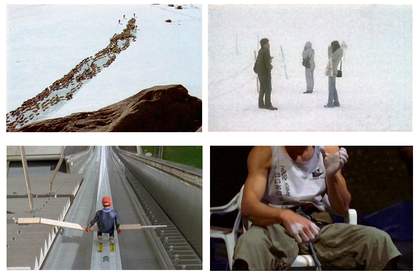
Film stills from Armin Linke's video installation Alpi Film Project 2008
Courtesy the artist © Armin Linke
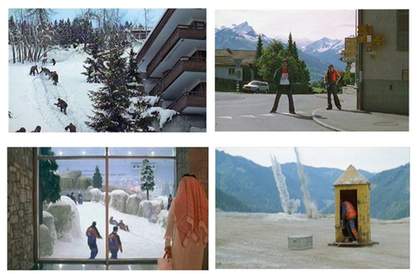
Armin Linke
Alpi Film Project 2008
Video installation
Still frames
Courtesy the artist © Armin Linke
On the way back south, we drive up the Engadine valley where resorts bristle with hotels jumbling together ostentatious palace architecture with half-timbered chalets. Chic shopping arcades and rustic hostels for alpinists alternate with sites of literary and artistic lore. While Marcel Proust journeyed to the coast of Normandy, Friedrich Nietzsche and Giovanni Segantini sought out the bracing alpine landscapes. To this day, travellers match their mental pictures of the valleys with present-day reality, remaining baffled as often as elated. Where Dr Moriarty and Sherlock Holmes plunged to their deaths, or where Nietzsche beheld a midnight vision of fated returns, four and five-star hotels beckon tourists to the edge of the abyss and induce a faint frisson of the sublime. We cast only a strafing glance up at the fake chateau of Zuoz with its wing recently designed by Ben van Berkel as a crystalline object of intriguing nature. Driving on to St Moritz, we make an obligatory stop, not only to acquire confections of nut and pear cake, but most of all to spend a quiet moment contemplating Segantini’s panoramic triptych Life, Nature, Death 1896–9. For the price of a cinema ticket, one can witness these truly cinematic paintings from the turn of the century inside a rotunda in St Moritz’s Segantini Museum. Three wide canvases open up magnificent views whose differences carry an urgent sense of the passage of time and the fragility of life.
Segantini’s triptych was in Linke’s mind when he conceived the three-screen projection of still and moving images for the Venice Biennale of 2003. The project, made in collaboration with artist/composer Renato Rinaldi and architect Piero Zanini, did not end there, and is now taking on new dimensions. Linke has been preparing an Alpen film symphony of his own – an ongoing pictorial documentation of the Alps – with Nietzschean overtones: short cinematic scenes caption sublime settings with everyday experiences, such as military manoeuvres, shepherds leading their flocks, meteorological simulations with dry ice and skiers storming the highest peaks in mechanical conveyances. At the time when our assault on the Alps renders the livelihood of its seasoned inhabitants ever more precarious, the lowlanders arrive in droves for simulated snowfalls, artificial cascades and night-time skiing. An episode on top of one of Europe’s tallest mountains baffles by its near-invisibility: tourists staggering through thick blankets of fog, careering over snowy slopes and posing for pictures in which there will be nothing but veils of white and spectral shadows. As if the camera were the only instrument to fix an evanescent moment of experience, everyone is wielding one, and Linke was on site to observe – with his – the uselessness of everyone else’s.
On the way down to Milan, we spend a moment in the cemetery at the Church of San Giorgio in Borgonovo in the Bregaglia valley to visit the tombs of the Giacometti family: a boulder smoothed down by Alberto for the grave of his father Giovanni, and little more than a slab of granite set up by Diego for his brother, but vandalised and now bearing flowers and pebbles left by visitors. Alberto transformed a stone from the nearby river bed into a torso, raising shallow shapes of sun and moon and a bird from its surface. As we bend over the boulder, the sun is setting behind the peaks. Giacometti’s torso is already sinking into uncanny twilight. Only by running one’s hand over the stone, still warm from the day’s heat, can one feel the irregularities of its shape. Water and wind have worn its surface; lichens have spread yellowish blotches over it. We sense, like a cold exhalation, the geology of time. The rapid eclipse of sunlight darkens the bottom of the valley under a radiant sky.
For several years Armin Linke has fashioned a series of simultaneous episodes that momentarily expand into panoramic continuity, thereby eluding our visual grasp, and sudden plunges into depth – like ski jumpers descending the launch ramp. Lateral expanse and focused depth imply different times of experience and combine to build the several rhythms of his images. These pictures move even when they are still, and they muffle the swish of time, although we hear clanking cowbells or the crashing sound of falling rock. Life is made of noise and rush alternating with uncanny moments of stillness and loss. Linke has found a way of bringing them into view without allowing time to shred his images. In an embrace as astonishing as it is spontaneous, he matches fleeting moments with the watchful permanence of pyramids.
